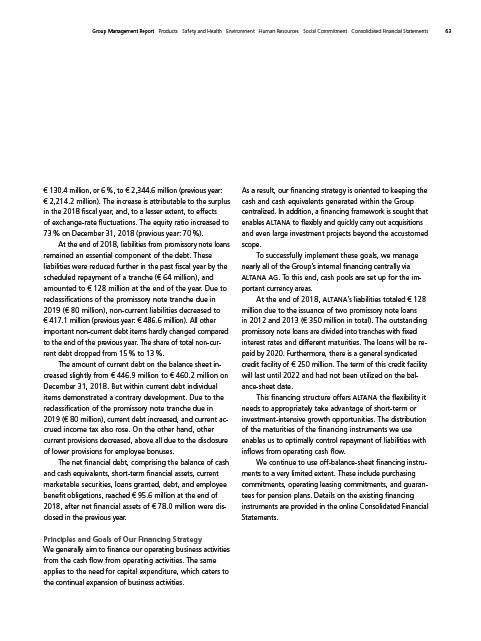
Group Management Report Products Safety and Health Environment Human Resources Social Commitment Consolidated Financial Statements 63
€ 130.4 million, or 6 %, to € 2,344.6 million (previous year:
€ 2,214.2 million). The increase is attributable to the surplus
in the 2018 fiscal year, and, to a lesser extent, to effects
of exchange-rate fluctuations. The equity ratio increased to
73 % on December 31, 2018 (previous year: 70 %).
At the end of 2018, liabilities from promissory note loans
remained an essential component of the debt. These
liabilities were reduced further in the past fiscal year by the
scheduled repayment of a tranche (€ 64 million), and
amounted to € 128 million at the end of the year. Due to
reclassifications of the promissory note tranche due in
2019 (€ 80 million), non-current liabilities decreased to
€ 417.1 million (previous year: € 486.6 million). All other
important non-current debt items hardly changed compared
to the end of the previous year. The share of total non-current
debt dropped from 15 % to 13 %.
The amount of current debt on the balance sheet increased
slightly from € 446.9 million to € 460.2 million on
December 31, 2018. But within current debt individual
items demonstrated a contrary development. Due to the
reclassification of the promissory note tranche due in
2019 (€ 80 million), current debt increased, and current accrued
income tax also rose. On the other hand, other
current provisions decreased, above all due to the disclosure
of lower provisions for employee bonuses.
The net financial debt, comprising the balance of cash
and cash equivalents, short-term financial assets, current
marketable securities, loans granted, debt, and employee
benefit obligations, reached € 95.6 million at the end of
2018, after net financial assets of € 78.0 million were disclosed
in the previous year.
Principles and Goals of Our Financing Strategy
We generally aim to finance our operating business activities
from the cash flow from operating activities. The same
applies to the need for capital expenditure, which caters to
the continual expansion of business activities.
As a result, our financing strategy is oriented to keeping the
cash and cash equivalents generated within the Group
centralized. In addition, a financing framework is sought that
enables ALTANA to flexibly and quickly carry out acquisitions
and even large investment projects beyond the accustomed
scope.
To successfully implement these goals, we manage
nearly all of the Group’s internal financing centrally via
ALTANA AG. To this end, cash pools are set up for the important
currency areas.
At the end of 2018, ALTANA’s liabilities totaled € 128
million due to the issuance of two promissory note loans
in 2012 and 2013 (€ 350 million in total). The outstanding
promissory note loans are divided into tranches with fixed
interest rates and different maturities. The loans will be repaid
by 2020. Furthermore, there is a general syndicated
credit facility of € 250 million. The term of this credit facility
will last until 2022 and had not been utilized on the balance
sheet date.
This financing structure offers ALTANA the flexibility it
needs to appropriately take advantage of short-term or
investment-intensive growth opportunities. The distribution
of the maturities of the financing instruments we use
enables us to optimally control repayment of liabilities with
inflows from operating cash flow.
We continue to use off-balance-sheet financing instruments
to a very limited extent. These include purchasing
commitments, operating leasing commitments, and guarantees
for pension plans. Details on the existing financing
instruments are provided in the online Consolidated Financial
Statements.